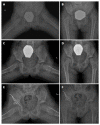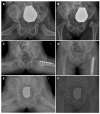Developmental dysplasia of the hip: What has changed in the last 20 years?
- PMID: 26716085
- PMCID: PMC4686436
- DOI: 10.5312/wjo.v6.i11.886
Developmental dysplasia of the hip: What has changed in the last 20 years?
Abstract
Developmental dysplasia of the hip (DDH) describes the spectrum of structural abnormalities that involve the growing hip. Early diagnosis and treatment is critical to provide the best possible functional outcome. Persistence of hip dysplasia into adolescence and adulthood may result in abnormal gait, decreased strength and increased rate of degenerative hip and knee joint disease. Despite efforts to recognize and treat all cases of DDH soon after birth, diagnosis is delayed in some children, and outcomes deteriorate with increasing delay of presentation. Different screening programs for DDH were implicated. The suspicion is raised based on a physical examination soon after birth. Radiography and ultrasonography are used to confirm the diagnosis. The role of other imaging modalities, such as magnetic resonance imaging, is still undetermined; however, extensive research is underway on this subject. Treatment depends on the age of the patient and the reducibility of the hip joint. At an early age and up to 6 mo, the main treatment is an abduction brace like the Pavlik harness. If this fails, closed reduction and spica casting is usually done. After the age of 18 mo, treatment usually consists of open reduction and hip reconstruction surgery. Various treatment protocols have been proposed. We summarize the current practice for detection and treatment of DDH, emphasizing updates in screening and treatment during the last two decades.
Keywords: Children; Developmental dysplasia; Developmental dysplasia of the hip; Hip; Infant; Newborn.
Figures






Similar articles
-
Cochrane Review: Screening programmes for developmental dysplasia of the hip in newborn infants.Evid Based Child Health. 2013 Jan;8(1):11-54. doi: 10.1002/ebch.1891. Evid Based Child Health. 2013. PMID: 23878122 Review.
-
Ilfeld abduction orthosis is an effective second-line treatment after failure of Pavlik harness for infants with developmental dysplasia of the hip.J Bone Joint Surg Am. 2015 Feb 18;97(4):292-7. doi: 10.2106/JBJS.N.00707. J Bone Joint Surg Am. 2015. PMID: 25695980 Clinical Trial.
-
Abduction bracing after Pavlik harness failure: an effective alternative to closed reduction and spica casting?J Pediatr Orthop. 2013 Jul-Aug;33(5):536-9. doi: 10.1097/BPO.0b013e31827d7e2a. J Pediatr Orthop. 2013. PMID: 23752152
-
Use of an abduction brace for developmental dysplasia of the hip after failure of Pavlik harness use.J Pediatr Orthop. 2003 Mar-Apr;23(2):175-7. J Pediatr Orthop. 2003. PMID: 12604946
-
Developmental dysplasia of the hip: update of management.EFORT Open Rev. 2019 Sep 17;4(9):548-556. doi: 10.1302/2058-5241.4.180019. eCollection 2019 Sep. EFORT Open Rev. 2019. PMID: 31598333 Free PMC article. Review.
Cited by
-
Musculoskeletal ultrasound: a useful tool for diagnosis of hip developmental dysplasia: One single-center experience.Medicine (Baltimore). 2019 Jan;98(2):e14081. doi: 10.1097/MD.0000000000014081. Medicine (Baltimore). 2019. PMID: 30633215 Free PMC article.
-
Variables influencing the pelvic radiological evaluation in children with developmental dysplasia of the hip managed by closed reduction: a multicentre investigation.Int Orthop. 2020 Mar;44(3):511-518. doi: 10.1007/s00264-020-04479-z. Epub 2020 Jan 22. Int Orthop. 2020. PMID: 31965310
-
Closed Reduction and Spica Cast Immobilization in Patients Aged 18 Months and Older With Developmental Dysplasia of the Hip.Orthop Surg. 2025 Jun;17(6):1702-1709. doi: 10.1111/os.70043. Epub 2025 Apr 22. Orthop Surg. 2025. PMID: 40260515 Free PMC article.
-
Normal variation of infant hip development : patterns revealed by 3D ultrasound.Bone Jt Open. 2022 Nov;3(11):913-923. doi: 10.1302/2633-1462.311.BJO-2022-0081.R1. Bone Jt Open. 2022. PMID: 36440537 Free PMC article.
-
Does a Graf Type-I Hip Justify the Discontinuation of Pavlik Harness Treatment in Patients with Developmental Dislocation of the Hip?Children (Basel). 2022 May 20;9(5):752. doi: 10.3390/children9050752. Children (Basel). 2022. PMID: 35626929 Free PMC article.
References
-
- Guille JT, Pizzutillo PD, MacEwen GD. Development dysplasia of the hip from birth to six months. J Am Acad Orthop Surg. 2000;8:232–242. - PubMed
-
- Klisic PJ. Congenital dislocation of the hip--a misleading term: brief report. J Bone Joint Surg Br. 1989;71:136. - PubMed
-
- Aronsson DD, Goldberg MJ, Kling TF, Roy DR. Developmental dysplasia of the hip. Pediatrics. 1994;94:201–208. - PubMed
-
- Vitale MG, Skaggs DL. Developmental dysplasia of the hip from six months to four years of age. J Am Acad Orthop Surg. 2001;9:401–411. - PubMed
-
- American Academy of Pediatrics. Clinical practice guideline: early detection of developmental dysplasia of the hip. Committee on Quality Improvement, Subcommittee on Developmental Dysplasia of the Hip. American Academy of Pediatrics. Pediatrics. 2000;105:896–905. - PubMed
Publication types
LinkOut - more resources
Full Text Sources
Other Literature Sources
Research Materials

